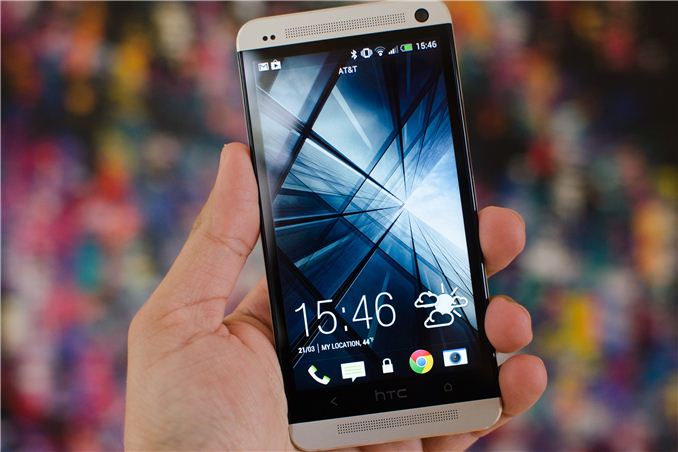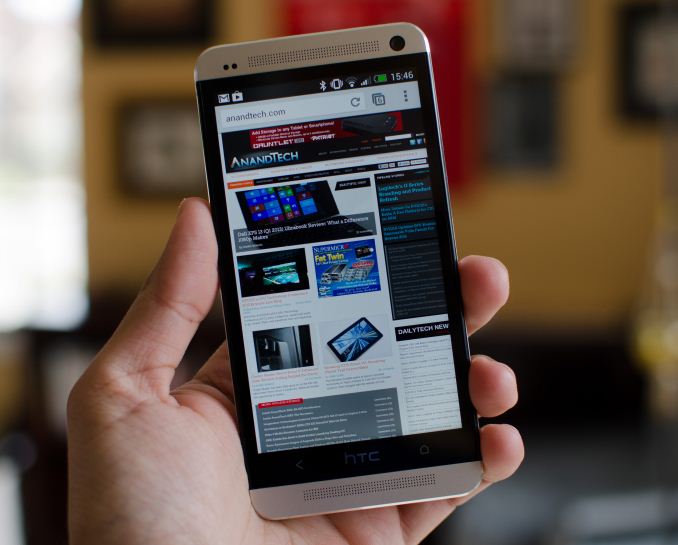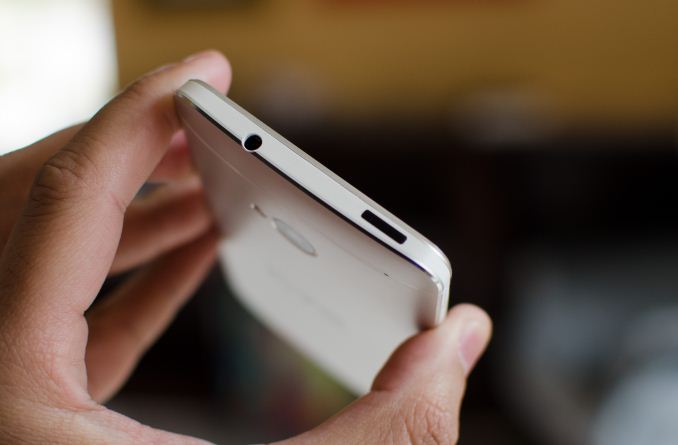The HTC One: A Remarkable Device, Anand’s mini Review
by Anand Lal Shimpi on March 21, 2013 4:49 PM EST- Posted in
- Smartphones
- HTC
- Mobile
- HTC One

For the past week and a half our own Brian Klug has been hard at work on his review of HTC’s new flagship smartphone, the One. These things take time and Brian’s review, at least what I’ve seen of it, is nothing short of the reference piece we’ve come to expect from him.
In the same period of time I’ve been playing around with a retail HTC One and felt compelled to share my thoughts on the device. It’s rare that I’m so moved by a device to chime in outside of the official review, but the One is a definite exception. By no means is this a full review, and I defer to Brian for the complete story on the One - something we should be getting here in the not too distant future.
I’m not a financial analyst, but HTC hasn’t been doing all that well over the past few quarters. There’s a general feeling that the aptly named One is HTC’s last chance at survival. Good product doesn’t always translate into market dominance, but it’s a necessary component when you’re an underdog. Luckily for HTC, the One is great.
Design
Over the past two years HTC has really come into its own as far as design is concerned. The difference between the HTC One X and the plethora of flagships that came before it was remarkable. Moving to the One, the difference is just as striking.
I don’t seem to mind plastic phones as much as everyone else, but the One is in an appreciably different league compared to its peers. It’s the type of device that you just want to look at and touch. Given how much you do end up looking at and touching your smartphone, HTC’s efforts here seem well placed.
The One looks and feels great. The proportions are a little awkward in my hands, but I fully concede that’s going to vary from person to person. Despite the heavy use of aluminum, I don't feel overly worried about scratching/damaging the finish.
The challenge with any smartphone is to build something that looks distinct in a sea of black rectangles on a wall in a store. With the One (and arguably the One X before it), HTC does a good job of balancing the need to be seen with the need to be subtle. Elegant is the right word here.
While I’m sure there will be comparisons to the iPhone, the fact of the matter is that the design cycle on these smartphones falls somewhere in the 12 - 24 month range. With something as sophisticated as the One, you’re looking at the longer end of that spectrum. For what it’s worth, if I had to estimate I’d say design work on the One probably started before the iPhone 4S came out.
| Smartphone Spec Comparison | ||||||
| Apple iPhone 5 | HTC One | Samsung Galaxy S 3 | Samsung Galaxy S 4 | |||
| SoC | Apple A6 1.3GHz | Snapdragon 600 1.7GHz | Snapdragon S4 1.5GHz | Exynos 5 Octa (1.6/1.2GHz) or Snapdragon 600 1.9GHz | ||
| DRAM/NAND/Expansion | 1GB LPDDR2, 16/32/64GB NAND | 2GB LPDDR2, 32/64GB NAND | 2GB LPDDR2, 16/32GB NAND, microSD | 2GB LPDDR3, 16/32/64GB NAND, microSD | ||
| Display | 4.0-inch 1136 x 640 LCD | 4.7-inch SLCD3 1080p, 468 ppi | 4.8-inch Super AMOLED 720p, 306 ppi | 5-inch Super AMOLED 1080p, 441 ppi | ||
| Network | 2G / 3G / 4G LTE Cat 3 | 2G / 3G / 4G LTE Cat 3 | 2G / 3G / 4G LTE Cat 3 | 2G / 3G / 4G LTE Cat 3 (depending on region) | ||
| Dimensions | 123.8mm x 58.6mm x 7.6mm | 137.4mm x 68.2mm x 4mm - 9.3mm | 136.6mm x 70.6mm 8.6mm | 136.6mm x 69.8mm x 7.9mm | ||
| Weight | 112g | 143g | 133g | 130g | ||
| Rear Camera | 8MP | 4MP w/ 2µm pixels | 8MP | 13MP | ||
| Front Camera | 1.2MP | 2.1MP | 1.9MP | 2MP | ||
| Battery | Internal 5.45 Wh | Internal 8.74 Wh | Removable 7.98 Wh | Removable 9.88 Wh | ||
| OS | iOS 6.1.2 | Android 4.1.2 | Android 4.1.2 | Android 4.2.2 | ||
| Connectivity | 802.11a/b/g/n, BT 4.0, USB 2.0, GPS/GNSS | 802.11ac/a/b/g/n + BT 4.0, USB2.0, GPS/GNSS, IR LED, MHL, DLNA, NFC | 802.11a/b/g/n, BT 4.0, USB 2.0, NFC, GPS/GNSS, MHL | 802.11a/b/g/n/ac (HT80) + BT 4.0, USB 2.0 NFC, GPS/GNSS, IR LED, MHL 2.0 | ||












434 Comments
View All Comments
darwinosx - Friday, March 22, 2013 - link
VaporwareCeriseCogburn - Friday, March 22, 2013 - link
vaporware is apple stock fellaEgg - Thursday, March 21, 2013 - link
You are right. It will probably not be better than any high-MP sensor with the same size if they both scale down to the same resolution.That's why the HTC One has a larger sensor. 1/3" instead of 1/3.2"...
Johnmcl7 - Thursday, March 21, 2013 - link
"Sealed battery, non-expandable battery, 4MP camera will be deal breakers for many.The 'Ultrapixel' is just marketing gimmick for low resolution sensor. Yes, it will be better than SMALL low-MP sensors but I doubt they are any better than high-MP sensor with same size. 36MP D800 is almost as good as any low-MP DSLRs with the same sensor size."
The D800 is a good demonstration that more pixels aren't an issue, it's not just almost as good as low-MP DSLRs it currently has the top rating on DXOMark and the next cameras down (D600, RX1) are using the 24MP FX sensor which has the second highest resolution for current selling full frame cameras.
John
Pylon757 - Thursday, March 21, 2013 - link
Except the D800 pixels, at 5.5um each, is not going to be constrained by optics and still has a lot of a headroom. A 1.1um pixel, at only 1.5 wavelengths of light, is really pushing it.darwinosx - Friday, March 22, 2013 - link
No it won't Most consumers don't care.CeriseCogburn - Friday, March 22, 2013 - link
the 4mp camera is a deal breakerphillyry - Sunday, March 24, 2013 - link
Why's that?Is it the optics or just the optics of the situation?
CeriseCogburn - Monday, March 25, 2013 - link
Spread your fingers out on the screen.DEECEE - Friday, March 29, 2013 - link
No, it's physics, for a given sensor size, the larger sensor pitch (distance between sites) will always give better low light noise performance all other factors being equal. Unfortunately, it's very difficult to have "all other factors" being equal, and higher performance CMOS chips in high end dSLR's always demands the price premium for that pixel density with "almost" equivalent noise performance. But you can't deny the advantage of a larger pixel pitch to low light noise performance.